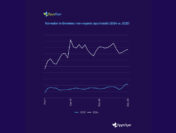
With over 135 million internet users, more than 71 million active on social media and around 400 million mobile devices, the Arab world is heavily influenced by the digital revolution. In an age when conversations start and spread both on and offline, organizations have to be agile to capture opportunities in real time. But most marketing organizations continue to operate by standards set in the 1950’s. Outdated organization charts fuel departmental and divisional silo-ism, while collaboration and integration remains limited.
The days when a generalist marketing team developed static, long-term brand strategies based on generic market research are over. Indeed, marketers understand the need to overhaul their organizations, but the question is how? To answer this question, Millward Brown Vermeer, the global marketing consultancy, led an unprecedented global research initiative: “Marketing2020 – Organizing for Growth.” Based on 10,000 surveys with marketers across 92 countries, and 350 in-depth interviews with CMO’s and opinion leaders from the world’s leading brands, Marketing2020 examined how over-performing organizations align marketing strategy, structure and capability to unleash business growth.
The study concluded that today’s businesses require a cultural mindset shift and an organizational model that is designed to deliver more flexibility in expertise and more speed in supporting highly connected and empowered teams. Over-performing companies think holistically about what operating model will enable delivery of its brand purpose, strategies, and consistent consumer experiences across all touch points. To engage with connected consumers, companies in the region must learn to organize in a more effective way; Marketing 2020 defined what winning companies do in each element of their operating models – structure, people, process, tools – and what practical things they can implement in a relatively short time.
People
With a single click, companies can reach millions of people; however this raises an important question about the role of people in this new relationship model between brand and consumer. Consumers need to see the human side of the brand to establish a strong and trustworthy rapport. The right people must be in place to successfully create a total consumer experience and integrated solutions. “Right people” embrace the company culture, values, behaviors, and competencies required to deliver the brand strategy. In over-performing organizations, leaders ignite change and lead from the start. They think differently about talent and advocate learning, partnering with HR to recruit and train. They move away from “command and control” by empowering employees. Further, they create future leaders by motivating millennial employees and strengthen consumer relation by taking away the robotic sense of digital through a consistent and personal tone of voice and messaging system.
One prime example of this is Zappos. The firm is offering a ‘bonus’ of two thousand dollars to employees who quit – not to reduce staff, but to encourage employees who are not passionate about their jobs to move on. Consequently, Zappos is able to recruit and invest in people who are a better fit. Additionally, employee packages are quite generous, with paid time for volunteer work and free medical benefits. It is no surprise that Zappos ranks 86th in Fortune’s Top 100 Best companies to Work For.
Structure
The digital age is constantly recreating the dynamics of business operation and in order to evolve and win in this volatile environment, companies are obliged to change the way they are structured. It is not just about the org chart: it is about one networked organization collaborating to achieve an aligned strategy. Marketers must embrace a more fluid and integrated organization capable of delivering a total consumer experience around their brand’s positioning. The organization must be networked across functions, teams, and partners. The structure that supports such strategic success requires marketing leaders to break down silos, orchestrate a team of specialists, build communities of excellence, refine decision making flows, and clearly establish business KPI’s.
One prime example of this is P&G. Last year, the FMCG giant broke down regional silos when it changed the function of its ‘marketing’ department to ‘Brand management’ – and integrated it into P&G’s four global business units; Beauty, Health and Grooming, Family Care and Home Care. By integrating brand management, P&G unified brand-building resources, clarified roles and responsibilities and freed up its structure to allow for more creativity. Although its business units still operate independently, they all take part in P&G’s ‘center of excellence,’ allowing for globally scaled benefits AND a local focus.
Process
In addition to having the right structure and people in place to support the company’s strategy, marketers must define how the actual work happens in the organization. Well-defined processes lead to predictability, stability and higher quality, while reducing inefficiencies. The key is to define the most critical processes – those that differentiate your company from competitors and allow your company to excel. Once the processes are defined, marketing leaders need to activate and embed throughout the organization. Over-performing organizations create strategic clarity with simple guardrails and push decision making rights down to the right levels. They also ensure interdependencies between functions to dramatically shorten approval times – befriending legal is a prime example of such interdependency.
Apple: Successful innovation processes – Integral to Apple’s success is its clear process for design and innovation teams. In short, Sr. Executives articulate their vision and small teams split out to prepare a case for their best ideas. Every week, Apple holds separate brain-storming sessions for left and right brain thinkers; left brain meetings are responsible for posing extraordinary ideas, followed by right brain meetings that focus on the feasibility and logistics of these ideas. By having clear design and innovation processes in place, Apple is able to secure its competitive advantage and become the first 700 billion dollar company in the world.
Tools
In today’s digital world, decisions must be based and dealt with in real-time. Firms need analytic tools to synthesize big data to capture insights. Over-performers recognize the need for iterative improvement, capturing what works and hardcoding collaboration, investing in excellence programs, and ensuring communication and connectivity within the organization. The best tools allow you to answer “Yes” to questions such as: “does it increase responsiveness?”, “does it feel organic to how we work?”, “does it help us share and codify best practices?”, “does it foster collaboration?” and “does it equip my team to win and serve as brand ambassadors to the outside world?”
Netflix: Handling Big Data
Businesses sit on data goldmines, but very few know how to harness this information to improve their consumer experience. Netflix is the exception. Netflix is equipped with cutting edge analytic tools that synthesize Big Data insights to customize every aspect of its customer experience strategy. Today, Netflix knows your movie preferences better than you do yourself! The super savvy streaming giant has amassed over 70mln subscribers, and continues to outpace traditional market competitors at an ever faster rate.
To resonate with today’s consumers, companies must re-engineer their operating models across structure, people, process, tools. Marketing 2020 represents the shared principles of the organizational approaches of over-performing companies, which THINK marketing in a digital age, not digital marketing, BELIEVE in integration, not hand-offs, and ORGANIZE within a holistic operating model, not just with organigrams. The result? Thriving companies successfully leveraging technology to deliver winning products, services, and total consumer experiences in the digital era.




